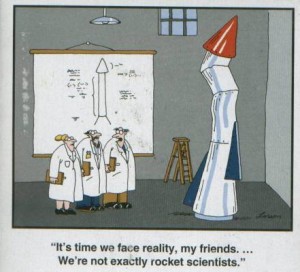 B2B customers have become more independent buyers in the procurement process as a result of their increasing access to information, research and peer-recommendations. In fact, this modern buyer is something of an enigma to B2B vendors. Traditional lead generation efforts such as trade show and publication advertising, direct mail, email, etc. are decreasing in effectiveness. Lead generation through social marketing has received much hype yet case studies demonstrating real bottom-line impact are still few and far between. How does one capture their attention (and wallet-share) in an environment where competition has surpassed competitive vendors to include the increasing availability of information and perception driven by customers and non-customers alike?
B2B customers have become more independent buyers in the procurement process as a result of their increasing access to information, research and peer-recommendations. In fact, this modern buyer is something of an enigma to B2B vendors. Traditional lead generation efforts such as trade show and publication advertising, direct mail, email, etc. are decreasing in effectiveness. Lead generation through social marketing has received much hype yet case studies demonstrating real bottom-line impact are still few and far between. How does one capture their attention (and wallet-share) in an environment where competition has surpassed competitive vendors to include the increasing availability of information and perception driven by customers and non-customers alike?
Customer Experience
The Nature of Situational Influence
 In 1610 Galileo, now considered the father of modern science and observational astronomy, began to publicly support the belief that the sun, not the earth, was the center of our universe. His heliocentric beliefs met with bitter opposition from his peers and the church who condemned him as a heretic. It was no coincidence, as it has always been, that those who benefit most from the status quo prove to be the most resistant to any kind of opposing thought, no matter how much sense it makes.
In 1610 Galileo, now considered the father of modern science and observational astronomy, began to publicly support the belief that the sun, not the earth, was the center of our universe. His heliocentric beliefs met with bitter opposition from his peers and the church who condemned him as a heretic. It was no coincidence, as it has always been, that those who benefit most from the status quo prove to be the most resistant to any kind of opposing thought, no matter how much sense it makes.
After a year of exploring the nature of influence, I firmly believe I am now, and have always been, inconsequential. That being said I also believe, like Galileo did about the sun and earth, that our view of influence is strongly based on the beliefs of those that benefit from it the most. This current self-centered view of influence puts man/woman as the center of the influence universe – a view I do not share and believe to be the exact opposite of the truth; a truth many would consider heresy.
The Importance of Brand Humility
 Even if you are absolutely certain that your product/service is one of the best on the market, what you think of your brand is not nearly as important as what your consumers think of it and say about it. They are, after all, the market!
Even if you are absolutely certain that your product/service is one of the best on the market, what you think of your brand is not nearly as important as what your consumers think of it and say about it. They are, after all, the market!
“Brand humility is the only response to a fast-changing and competitive marketplace. The humble brand understands that it needs to re-earn attention, re-earn loyalty and reconnect with its audience as if every day is the first day.” – Seth Godin (in a recent blog post)
In my opinion, Seth’s message is right on target. Brands simply cannot compete in this marketplace if they don’t make an ongoing effort to put aside ego-driven campaigns in order to genuinely engage with their consumers and potential consumers. Relationships require humility, whether it’s personal relationships, business relationships, or brand/consumer relationships.
Face-to-face Customer Service Still Matters
 I recently wrote about the dangers of disparity between the customer experience in the social media channel and the customer experience in the traditional channel … and the importance of INTEGRATING your brand messages across all channels.
I recently wrote about the dangers of disparity between the customer experience in the social media channel and the customer experience in the traditional channel … and the importance of INTEGRATING your brand messages across all channels.
We also need to make sure that we integrate our brand messages across platforms – both face-to-face and online.
Real-life example: I have been involved with my bank for years – I’m an Advocate, and I go to this bank all the time. This week after visiting my bank in their physical location, I walked out realizing that more often than not, I leave their “store” not feeling good.
Q&A: How to drive measurable ROI from social media NOW
Courtney Velasquez, Social Fabric Community Director, interviewed John Andrews, Collective Bias (CB) Founder/CEO, and Ted Rubin and Dave Henry of the CB Board of Advisors to understand how brands and retailers can measure social media ROI, engage in shopper listening and receive shopper feedback. Originally posted at CollectiveBias.com
1. How can brands drive measurable ROI from social media now?
John: This is such an important question! ROI is usually addressed from a longer-term perspective, and with the immediacy of social media interactions (and exponential growth and adoption), we really do need to see measurable ROI in the shorter term.
Ted: Social media is so popular and effective as a marketing tool because it focuses on the customer experience instead of just throwing an advertisement at them and hoping the impression will stick. The key, then, to driving measurable ROI is in customers’ shopping experience. JUST by listening to what shoppers want, you can improve their shopping experience (e.g. in-stock position, proper assortment, promotion placement, etc.) and grow your sales by a measurable effect immediately. Be a socially-focused organization.
Social Media Strategy: What doesn’t work
 You know what doesn’t work for a social media strategy? Not being social. It might sound like common sense, but all too often, being social is overlooked in a social media strategy. It’s not enough to just start accounts with all the most popular social media tools and community sites, even when you include professionally-designed graphics and a big bold display of your logo and a few text lines about your brilliant mission. First and foremost, you absolutely must BE SOCIAL!
You know what doesn’t work for a social media strategy? Not being social. It might sound like common sense, but all too often, being social is overlooked in a social media strategy. It’s not enough to just start accounts with all the most popular social media tools and community sites, even when you include professionally-designed graphics and a big bold display of your logo and a few text lines about your brilliant mission. First and foremost, you absolutely must BE SOCIAL!
When you are not being social, even if you think there is no message, you ARE sending a message to your consumers and potential consumers – and it is not a message you want to have associated with your brand. That message is… we don’t want to socialize.
No more mixed messages: Integrate Social Media Marketing!
 Social media marketing to most in the C-suite is still a campaign-based tactic, viewed and managed separately, but it really should be integrated. Social media marketing needs to be woven into the fabric of all marketing channels and strategically managed from a 360-degree perspective.
Social media marketing to most in the C-suite is still a campaign-based tactic, viewed and managed separately, but it really should be integrated. Social media marketing needs to be woven into the fabric of all marketing channels and strategically managed from a 360-degree perspective.
This integration is especially important around Customer Service, where the disparity between the customer experience in the social media channel and the customer experience in the traditional channel is a dangerous chasm. The result is a mixed message around Customer Service – an area where none of us can afford to be unclear or inconsistent!
Think of it from the customer perspective (as you always should): they get a quick response and dedicated attention in the social media channel, and then are subjected to the “same-old, same-old” via traditional customer service channel. Long waits (phone or in person) and inattention in one channel will immediately cancel out any gains from your social media marketing channel.
Influencers Want to be Influenced
 Let’s face it… customers don’t become influencers in order to champion brands out of the goodness of their hearts, or because of a brilliantly-designed logo or a couple coupons they can download from the internet.
Let’s face it… customers don’t become influencers in order to champion brands out of the goodness of their hearts, or because of a brilliantly-designed logo or a couple coupons they can download from the internet.
Customers become influencers because something about their experience with a brand influenced them first… and they want to continue that experience.
Influencers don’t want to be told what to do or what to buy, they want to have an experience so amazing that they are compelled to share it with their networks. It can be a product that proves to be everything it was advertised to be PLUS MORE, or impeccable and genuinely friendly customer service, or any other experience that was so out of the ordinary that it influenced the customer to form a solid opinion about the experience and then take action to encourage others toward that same experience.
Make Your Customers Feel at Home
 In the physical world, when our trusted and valued friends come to visit our house, we often welcome them by saying, “Come in…make yourselves at home!” In the virtual world, do you do the same thing? When customers and prospects visit your online site, do they feel at home there?
In the physical world, when our trusted and valued friends come to visit our house, we often welcome them by saying, “Come in…make yourselves at home!” In the virtual world, do you do the same thing? When customers and prospects visit your online site, do they feel at home there?
Think about retailers that offer snacks, coffee, samples, valuable information, and sometimes even entertainment in their shops. They create a welcoming atmosphere for their customers because they know it will encourage them to stay around the shop, browsing the products and learning more about the brand…and greatly increasing the chances of a sale.
Your online site needs to do the same thing. What do you do to make your current and prospective customers feel comfortable? What are you doing to add value to their day? What experience are you giving them? In other words, how are you inspiring them to stick around now and return later…with their friends?
Is Social Media Just a Channel?
 I have been in some interesting debates recently on Twitter in chats such as #mmchat and #techchat on whether or not Social Media is just another channel. While I disagree with almost every word these particular people type, I wanted to make sure this topic was approached objectively… well, somewhat objectively.
I have been in some interesting debates recently on Twitter in chats such as #mmchat and #techchat on whether or not Social Media is just another channel. While I disagree with almost every word these particular people type, I wanted to make sure this topic was approached objectively… well, somewhat objectively.
Why not just share my intensely subjective perspective on this subject? Well, here are a couple reasons…
- Its a burning question for many marketers (and now senior executives) that once answered provides perspective on strategy, integration, approach, internal/external policy, and execution of your social program.
- I take my responsibility as a blogger and consultant very seriously when it comes to presenting and arguing issues. The last thing you want is a lop-sided diatribe for or against… unless that’s your bag.